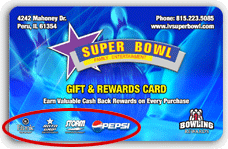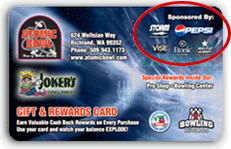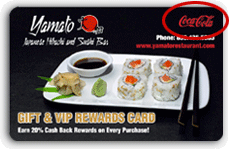SECURING SPONSORSHIPS - GETTING PAID TO GROW THE BUSINESS
Introduction
Whether your business is a restaurant, bowling center, automotive facility, golf course, or WHATEVER, Preferred Loyalty offers custom solutions which benefits sponsors and companies you write checks to as a business owner. A sponsor might be any company who can benefit by driving your customers to their brand, product or location. In addition, a sponsor might benefit from simple goodwill to their product or brand even if a ‘direct purchase’ strategy is not part of the game plan.
There is also a different group of sponsors which are directly related to your business and these are companies who prosper as a result of your personal or business success. Whether it’s your bank, real estate firm, or any personal contact, these ‘relationships’ are often local in nature and benefit directly from your participation with them either as a business owner or a personal purchase (such as your home). You have much more influence over these companies since you are a direct customer in some form or fashion and it’s often related to business success one way or another. This is the easiest group to attract ‘sponsorship dollars’ from since they prosper as a direct result of your business. Your business may already employ a form of sponsorship through the concept of co-op advertising where key vendors kick in advertising dollars toward a campaign that is mutually beneficial. We’re about to explain a much more profitable upgrade to the traditional co-op advertising model that can pay the costs of your entire loyalty program while increasing sales for both your business and your sponsor(s).
Securing sponsorships through your loyalty program can be a difficult proposition to explain so we designed this page to help educate you on the process. Don’t worry if you get confused or need help because Preferred Loyalty Authorized Agents are marketing specialists and help deliver custom solutions far beyond the initial purchase. We will help you with conference calls, custom presentations and other valuable steps to help you secure this ‘free money’ and develop new relationships which will pay you for years ON TOP of increasing revenue within your business!
Basic Branding Exposure
There are a number of opportunities to plug sponsor(s) logos and impressions throughout the retail experience, both online and off-line. First, we’ll discuss branding, a common form of media exposure which most sponsors are already aware. There are many different strategies you can employ to increase sponsor branding impressions, both inside and outside of your loyalty program. Here are a few examples:
- Card Branding: Offer potential sponsors the opportunity to place their logo on your batch of personalized rewards cards.
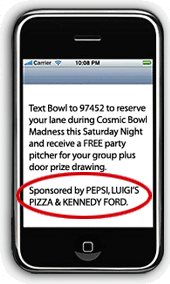
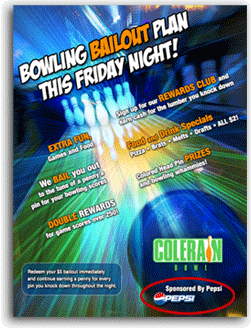
- Marketing Material Branding: Offer sponsors branding across various media inside the facility, such as video screen advertising, posters, menus, banners, etc.
- Website Branding: Add sponsor logos and advertising messages to your business website to help maximize branding exposure.
- Email Branding: Add sponsor logos and messages inside the automated thank-you emails Preferred Loyalty sends to customers the day after a visit.
- HTML Email / Mobile Text Branding: Give a plug to sponsors during regular email and/or mobile text marketing campaigns sent to customers on a regular basis.
- Receipt Footer Branding: Merchants can promote a message directly on the printed receipt after every transaction to give sponsors an additional plug.
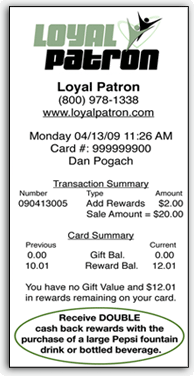
Beyond the Branding - Triggering Actual Sales
Now that we understand how to setup basic advertising impressions for sponsors, are you ready to learn the secret weapon that will deliver ROI to your sponsor brands like nothing else? It’s the critical piece missing from 95% of sponsorship agreements, a strategy that actually pushes consumers toward the sponsor brand through an actionable sales event. Any business can influence the purchase decision through a well executed loyalty program strategy which is beneficial for both parties. Unique sponsor promotions can be test marketed and tweaked for optimum sales success. Let’s take a look at some ideas on how retail businesses can literally increase sales of sponsor brands through their loyalty program.
- A car wash facility offers 25% to 50% cash back rewards toward a FREE car wash or detail ONLY when the full service wash is ordered using ArmorAll wheel protectant.
- A restaurant offers DOUBLE cash back rewards on the ENTIRE ticket when any Pepsi fountain drink or bottled beverage is ordered.
- A hair salon offers consumer rewards exclusively when Paul Mitchell hair care products are purchased.
- An oil change facility offers double rewards when Pennzoil is selected by the customer.
- A golf course or country club offers a FREE large bucket of balls on the driving range and FREE round on the golf course whenever any Taylor Made product is purchased.
Let’s use Pepsi as a case study illustration for the restaurant industry. For other retail stores, just substitute “Pepsi” for ANY vendor(s) that benefit from your sales success since the strategy works across multiple industries. Let’s assume the restaurant normally offers 10% cash back rewards with a $20.00 average ticket. However, if the consumer orders a Pepsi fountain drink or bottled beverage, he or she receives “Double Rewards” (20%) on the entire ticket which yields additional $2.00 in rewards on a $20 purchase.
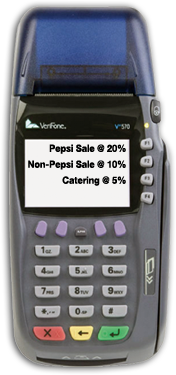
The price of a Pepsi might retail for $2.50 thus creating an immediate profit for the business owner and the sponsor (Pepsi) due to the increase in pour rates. Even if the Pepsi only retails for $0.75 the business owner wins after factoring in breakage ratios, the pace of redemptions, and consumer behavior. Remember, issuing rewards is NOT an expense to the business owner at the time of checkout; rather rewards issuance is a trigger to increase spending and visitation in the future. The business owner only incurs an actual expense when the rewards are redeemed (and even then a tax deduction is realized) which means the customer is spending more money and receiving a built in incentive to return on a future visit. Properly designed cash back rewards programs are also the biggest Word of Mouth beneficiaries in the industry.
Imagine how much more Pepsi the restaurant will sell due to the business owner’s ability to use their customer loyalty program to reward people for purchasing the brand. Would offers like this influence you as a consumer to buy more Pepsi? We have surveyed 100s of customers using the Pepsi illustration and have found that over 80% of them indicated they would ‘probably’ purchase the Pepsi when they would not have otherwise due to the increased benefits. Imagine the difference when it feels like the Pepsi is FREE or even better, the value to order a Pepsi exceeds the cost of the Pepsi itself! Even the extra rewards given to customers on Pepsi purchases increase store profitability through increased frequency and spending. Both the merchant and the sponsor win big.
There are many strategies like the above that actually encourage customers to purchase a select brand. The ROI becomes very clear to both the business owner and the sponsor after a few months (even weeks) of sales activity. Give the consumer a good reason to purchase using ‘monopoly money’ of rewards and sales of that brand will increase substantially.

THE THREE TENETS OF LOYALTY SPONSORSHIP
Before you can pitch prospective sponsors(s) on your ideas, you first need to clearly understand the following three tenants of loyalty sponsorship. These facts should be obvious, but we highlighted them below as a refresher prior to verbalizing the value prop to your vendors.
- Your Suppliers Have a Vested Interest in Your Business Success. If your business were to go bankrupt then the money you send your vendor would go away. If your business were to double in sales, then the money you give your vendor would increase substantially. Your vendor has skin in the game when it comes to your success and directly profits (or loses) based on the strength of your business.
- Your Current Vendor is Not the Only Game in Town. In most situations, you have a choice of vendors whom you choose to do business with. Even if you did not have a choice, doubling existing sales is still an attractive proposition. Without a contract in place, your current vendor has competitors who would love to supply your business. Pepsi and Coca-Cola are perfect examples. Sysco and US Foods are another, Budweiser and Coors yet another and you get the idea. Choosing one of these brands to influence customer purchases is a coup for sponsors and will drive ‘competition’ to their brand while increasing the purchase behavior of those already committed to the brand.
- True Business Partners Share Important Expenses. Purchasing a world class customer loyalty program is not the same purchase as adding chairs, painting the building, putting on a new roof or even purchasing a new POS system. The purchase of a customer loyalty program is arguably, the SINGLE MOST important investment a business owner can make to increase sales and business. Just understanding this one fact alone means we should seek marketing help from other businesses who prosper from our direct sales as a result. When two parties benefit from each other, then it should NOT be on the complete shoulders of the one partner to fund the most important purchase which will have a direct effect on the check you write the other partner every month. This is a partnership and partnerships share in important expenses, especially those directly related to the size of the check the other partner receives.
Understanding these three basic tenets of sponsorship is important but we are not going to hold the sponsor hostage into funding something that does not clearly make dollars and sense for everyone involved. The strategy needs to be win-win for all parties.
Negotiating the Sponsorship
The most attractive sponsorship deal is one in which the vendor gives business owners free product in lieu of real cash and the amount of product given is tied to actual metrics that can be measured and verified. Free product is just like real money to the business owner but costs sponsors far less due to the mark-up.
Even though we don’t know exactly how many extra sales will be generated from the loyalty sponsorship in Year 1, or know exactly how many customers will activate cards with a sponsor(s) logo on it, we can project in Year 1 and know for sure in Year 2. Therefore, we recommend pricing the sponsorship opportunity attractively at inception with an eye toward creating an annual residual tied to metrics that can be quantitatively measured in Year 2 and beyond.
Let us assume a projected $30,000 increase in sales to Pepsi in Year 1 as a result of our special promotion outlined above. How much should Pepsi contribute? Why not start with a paltry 10% of projected sales in Year 1 or $3,000.00 of free product. This commitment level is more then justified on logo branding alone (on a batch of 10,000 cards for example) but becomes a steal for the sponsor when you bundle a promotional sales strategy influencing customers to purchase the brand.
In Year 2 and beyond, sponsorship fees might be negotiated based on:
- A percentage of the sales increase over the year prior to program inception.
- Number of rewards cards featuring sponsor branding that have been successfully activated in the Preferred Loyalty system.
- Number of HTML email or mobile text sends with sponsorship exposure.
- Number of transactions with receipt footer sponsorship messages.
- Number of unique website visitors viewing sponsorship impressions online.
All of these metrics can be verified to evaluate program ROI. Even if you price annual sponsorship fees exclusively tied to the % of sales increases from the year before program inception, sponsor dollars are taken out of money which was NEVER given to the sponsor prior! Let’s look at a hypothetical example of a sponsorship program where the merchant charged the sponsor just $1,000 in cash or product over projected Year 1 sales increases to cover initial plastic card and setup costs. In Year 2 and beyond, sponsor fees are tied exclusively to 10% of the real increases in sales from Year 0 (the year before program inception).
Hypothetical Sponsorship Package & Fees
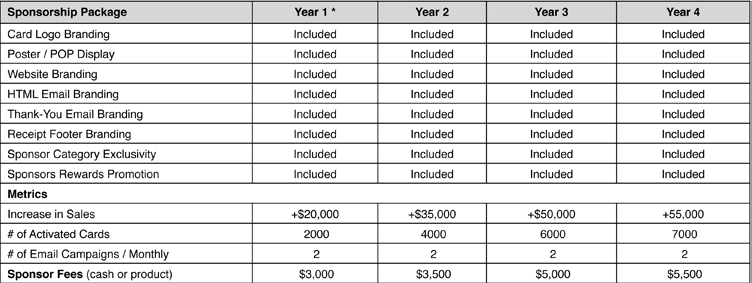 * Projected sales and activation figures during first year.
* Projected sales and activation figures during first year.
When the value prop is properly explained, what company would not want to risk a few thousand dollars of cash or product to potentially reap 10s of thousands in actual money every year? Also remember, this few thousand dollars we might ask for in Year 1, is being given to an existing customer writing checks to the sponsor for 5X or 10X that amount throughout the year. Let’s get real for goodness sakes. If the program does not work, then we don’t continue it, but it’s certainly worth a try isn’t it?
Contact Preferred Loyalty for Help
Negotiating sponsorship agreements does not come easily to many business owners but Preferred Loyalty is here to help. We’d be happy to brainstorm with you and help customize a strategy and marketing proposal you can take to your prospective sponsors. Contact your Preferred Loyalty Authorized Agent or our sales office directly to discuss your sponsorship strategy and for proposal writing assistance.
